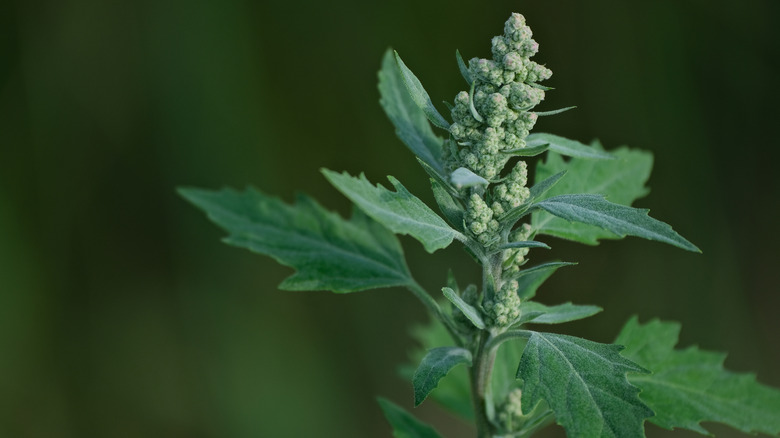The Common 'Weed' That Can Actually Be Super Beneficial To Your Garden
Gardening goes hand in hand with identifying common garden weeds. These often relentless, unwelcome plants serve as a nuisance to gardeners everywhere, choking out and overcrowding crops. But while many weeds are a cumbersome eyesore in a garden bed, others may actually be worth keeping around. In some scenarios, the lambsquarter weed may be a welcome trespasser.
Lambsquarter (Chenopodium album) is a part of the amaranth or pigweed family alongside chard, spinach, and beets. You may also hear it referred to as goosefoot due to its distinct serrated, diamond-shaped leaves. As an early summer annual, you will likely see lambsquarter pop up around May or June, although they can grow into the winter months as well. This hardy plant can withstand conditions ranging from scorching heat to frost and thrives in nutrient-dense, loose soil.
You might find lambsquarter in your garden bed, near barnyards, and throughout fields–really anywhere its seeds land. While its persistence can be an annoyance, there's a lot more to love about this plant than you may think. If you notice lambsquarter in your garden, consider its benefits before you take measures to get rid of a weed that is actually good to grow.
How to work with lambsquarter
Lambsquarter is an incredible addition to your garden when you know how to work with it. In India and Pakistan, lambsquarter isn't considered a nuisance. These communities actually cultivate the plant as a crop. Often compared to spinach, you can harvest the leaves, seeds, and stems to eat. Lambsquarter also serves as a great companion plant for crops such as beets and chard. It's considered a "trap crop," luring leaf-hungry pests away from more important plants. With its long taproot, lambsquarter may also serve as a great helper for plants with shallow roots. It draws both nutrients and water from far below, depositing them closer to the surface.
Lambsquarter grows in all 50 states and Canadian territories short of Nunavut. So, if you're interested in taking advantage of this plant, there's a good chance it's already growing in your yard. Each plant yields up to 176,000 seeds. Once lambsquarter takes root, it will likely stick around unless you intervene. At the end of its growing season, you can easily collect seeds once the flowers have dried out, preventing them from germinating and taking over your yard. If you don't happen to have lambsquarter growing on your property, you can also purchase seeds.
While it's tempting to reach for your gardening gloves and hand weeder at the first sign of a weed, stop to think about how it may benefit you and your garden. These surprise visitors often offer hidden perks, such as several unexpected ways they can be repurposed. From lambsquarter to beyond, weeds are a misunderstood plant worth learning more about.

